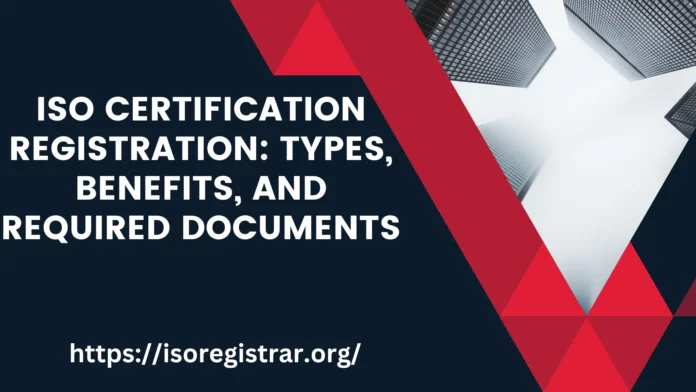Introduction:
ISO certification registration is an important process that helps organizations demonstrate their commitment to quality, safety, and efficiency. The International Organization for Standardization (ISO) sets internationally recognized standards that organizations can adhere to and become certified. In this detailed article, we will explore different types of ISO certifications, delve into the benefits they offer, and provide insights into the essential documents required for a successful ISO certification registration.
Understanding ISO Certification:
ISO certification is a formal recognition given to organizations that comply with specific international standards set by ISO. These standards ensure that organizations meet customer expectations, follow best practices, and continually improve their processes. ISO certifications are widely recognized and provide credibility to organizations in various industries.
Types of ISO Certifications:
ISO offers a diverse range of certifications, each tailored to specific business areas. Let’s explore some prominent types:
ISO 9001:2015 –
Quality Management System: ISO 9001 focuses on implementing a robust quality management system (QMS) to enhance customer satisfaction, improve product/service quality, and drive continual improvement within an organization.
ISO 14001:2015 –
Environmental Management System: ISO 14001 sets guidelines for implementing an effective environmental management system (EMS). It helps organizations minimize their environmental impact, comply with regulations, and demonstrate their commitment to sustainable practices.
ISO 45001:2018 –
Occupational Health and Safety Management System: ISO 45001 provides a framework for establishing an occupational health and safety management system (OHSMS). This certification helps organizations create safer work environments, reduce accidents, and protect the well-being of employees and stakeholders.
ISO 27001:2013 –
Information Security Management System: ISO 27001 focuses on information security management. It helps organizations identify and manage risks related to information security, protect sensitive data, and establish robust security controls.
Benefits of ISO Certification:
Obtaining ISO certification offers numerous advantages for organizations. Here are some key benefits:
Enhanced Credibility and Reputation:
ISO certification enhances an organization’s credibility and reputation, instilling trust in customers, suppliers, and stakeholders. It demonstrates that the organization follows recognized international standards and is committed to delivering high-quality products/services.
Improved Operational Efficiency:
ISO certification promotes process optimization and efficiency improvements within an organization. By implementing standardized procedures and continual improvement practices, organizations can enhance productivity, reduce waste, and streamline operations.
Expanded Market Opportunities:
ISO certification opens doors to new market opportunities. Many government and private sector contracts require ISO certification as a prerequisite, allowing certified organizations to compete for lucrative contracts and expand their business prospects.
Compliance with Legal and Regulatory Requirements:
ISO certifications often align with legal and regulatory requirements in various industries. Achieving certification ensures that organizations are compliant with relevant laws and regulations, minimizing legal risks and potential penalties.
Better Risk Management:
ISO standards focus on risk-based thinking, encouraging organizations to identify and mitigate potential risks. By implementing risk management practices outlined in ISO standards, organizations can proactively manage risks, prevent issues, and ensure business continuity.
ISO Certification Registration Process:
The ISO certification registration process typically involves the following steps:
Identify Relevant ISO Certification:
Organizations must identify the ISO certification that aligns with their industry, business objectives, and customer requirements.
Develop and Implement Systems:
Organizations need to develop and implement systems and processes that comply with the specific ISO standard. This may involve updating existing processes, establishing new procedures, and training employees.
Choose an Accredited Certification Body:
Selecting an accredited certification body is crucial. These bodies assess an organization’s compliance with ISO standards and issue the certification.
Pre-audit and Documentation Review:
Before the certification audit, organizations typically undergo a pre-audit or documentation review to ensure that all necessary documentation is in place and that processes align with ISO requirements.
Certification Audit:
The certification audit involves an on-site assessment by the certification body to verify that the organization meets all the requirements of the chosen ISO standard. This includes reviewing documentation, conducting interviews, and evaluating processes.
Post-certification Surveillance Audits:
After receiving ISO certification, organizations are subject to periodic surveillance audits to ensure ongoing compliance with ISO standards. These audits help maintain the certification’s validity.
Required Documents for ISO Certification Registration:
Accurate and comprehensive documentation is vital for ISO certification registration. The following documents are typically required:
Quality Manual: The quality manual outlines the organization’s quality management system, including its processes, responsibilities, and objectives.
Procedures and Work Instructions: Detailed procedures and work instructions describe how specific tasks and processes are performed within the organization. They provide step-by-step guidelines to ensure consistency and quality.
Records and Documentation: Organizations must maintain records and documentation that demonstrate compliance with ISO standards. These may include training records, quality control records, calibration records, and audit reports.
Internal Audit Reports: Internal audit reports document the results of internal audits conducted to assess the organization’s compliance with ISO standards. These reports highlight any non-conformances and corrective actions taken.
Corrective Action Reports: Corrective action reports outline any identified non-conformances, the actions taken to address them, and their effectiveness in preventing recurrence.
Management Review Reports: Management review reports document the organization’s periodic reviews of its quality management system. These reports discuss any necessary improvements, changes, or opportunities for enhancement.
Suggested Read: Online ISO Registration
Conclusion:
ISO certification registration is a significant undertaking for organizations seeking to demonstrate their commitment to quality, safety, and efficiency. By understanding the different types of ISO certifications, the associated benefits, and the required documents for the registration process, organizations can embark on a successful ISO certification journey. Achieving ISO certification not only enhances an organization’s reputation but also drives continual improvement and opens doors to new market opportunities in an increasingly competitive global landscape.

